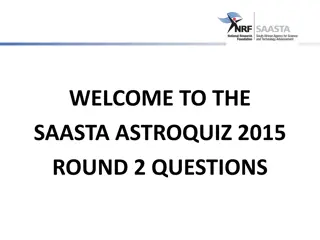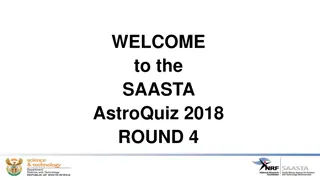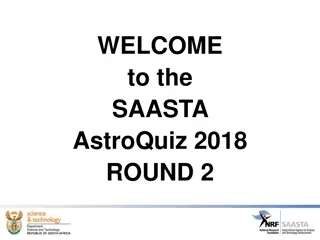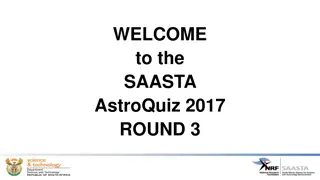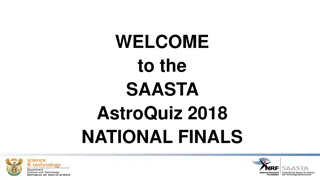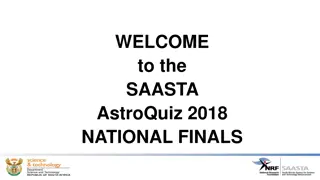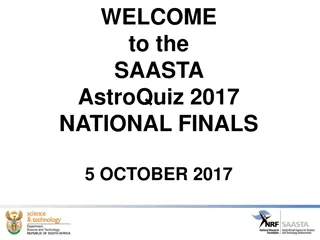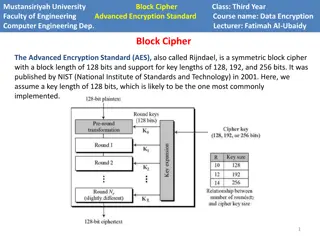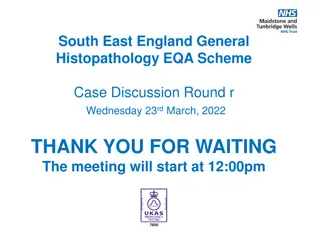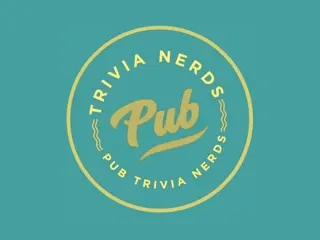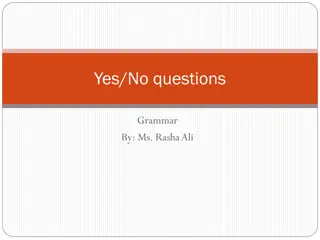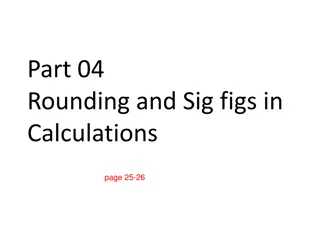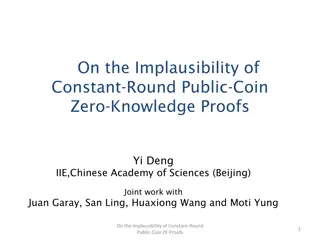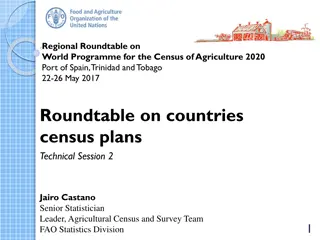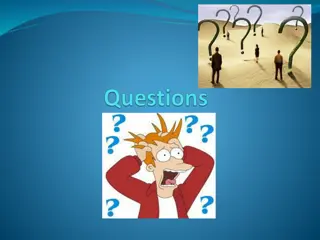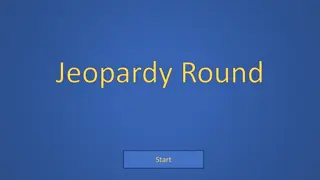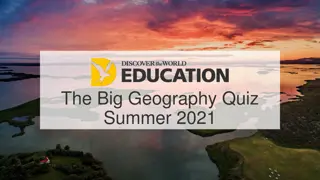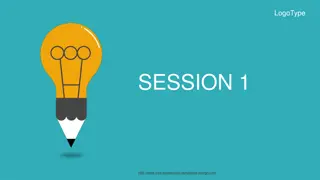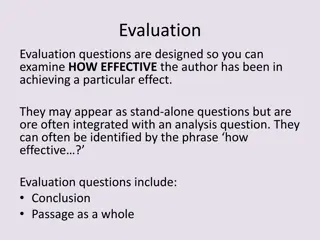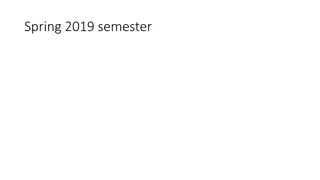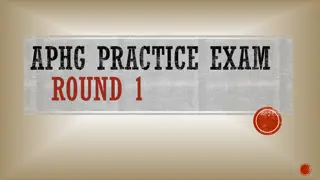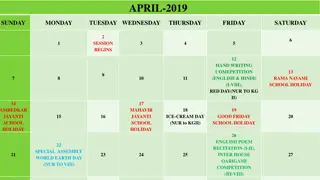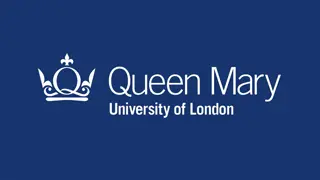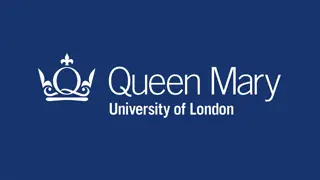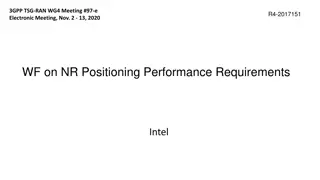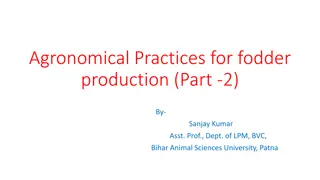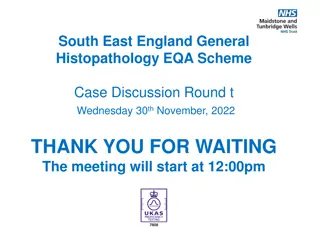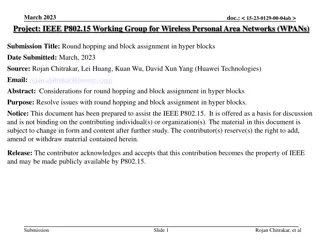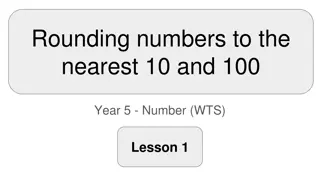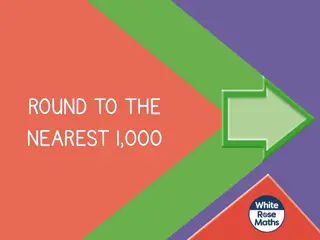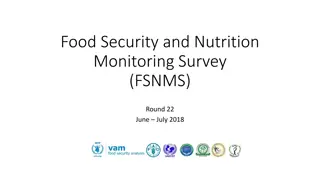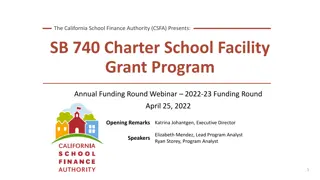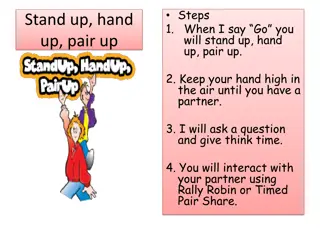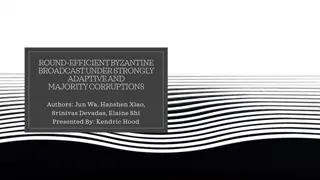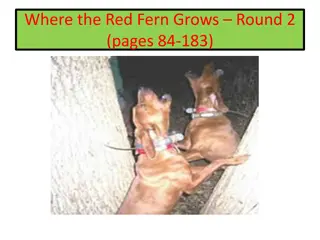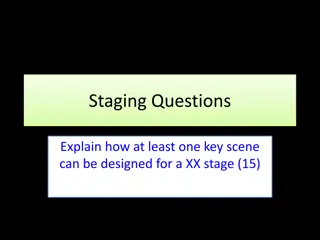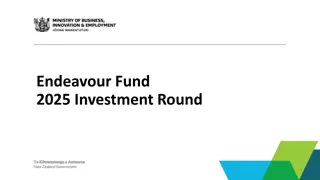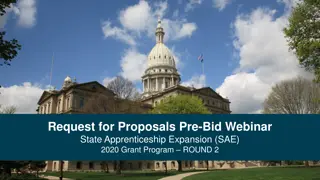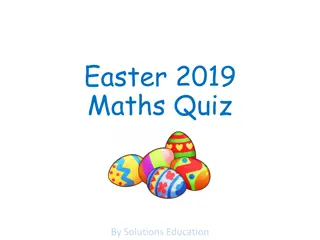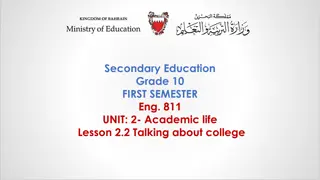AstroQuiz 2019 Round 4 Questions
Test your astronomical knowledge with these challenging questions about planets, stars, and celestial phenomena. From identifying the red planet to understanding equinoxes and the Earth's rotation, see how well you fare in this cosmic quiz!
Download Presentation

Please find below an Image/Link to download the presentation.
The content on the website is provided AS IS for your information and personal use only. It may not be sold, licensed, or shared on other websites without obtaining consent from the author. Download presentation by click this link. If you encounter any issues during the download, it is possible that the publisher has removed the file from their server.
E N D
Presentation Transcript
AstroQuiz 2019 ROUND 4
RULES You only have 60 seconds to answer each question. You are allowed to discuss amongst yourselves as team members Calculators may be used if needed. No internet is to be used, therefore the use of cellphones is also prohibited. The judge s decision is final.
QUESTION 1 Which planet is referred to as the red planet? A. Mercury B. Mars C. Jupiter D. Saturn
QUESTION 2 The planet in Question 1 above has a red colour, because A. it has been named after the Roman god of war. B. it is covered with iron oxide dust. C. it has a mixture of mud & water which gives it the red appearance. D. of the reflection of light from the Sun.
QUESTION 3 Which of the following is not produced in stars? A. Hydrogen B. Helium C. Carbon D. Oxygen
QUESTION 4 What is the heaviest element to form in the core of a star? A. Lithium B. Iron C. Carbon D.Uranium
QUESTION 5 Equinox refers to days when the day and night have equal lengths. How many times a year do we experience this? A. 4 times B. 3 times C. 2 times D. 12 times
QUESTION 6 How long does it take the reflected sunlight to reach us from the Earth s Moon? A. 8 minutes B. 1 hour C. 1 seconds D. 1 minute
QUESTION 7 The earth s axis is wobbling like a spinning top. This means that A. over ten thousand years ago our winter sky constellations were seen in summer. B. there are seasons. C. the Earth s rotation is slowing down. D. the Moon is moving away from us.
QUESTION 8 All planets in the solar system spin in the same direction. A. True B. False
QUESTION 9 All planets in the solar system revolve around the Sun in the same direction. A. True B. False
QUESTION 10 Why do all planets orbit in the same direction? A. They don t. Some actually orbit in the opposite direction. B. The solar wind gave them a kick. C. They were formed from a rotating disk of gas and dust. D. We don t know.
QUESTION 11 What is explained with dark energy? A. That the Universe gets bigger faster and faster B. That stars don t live forever C. That the sky is dark at night D. That Jupiter gets hit by more comets than Earth
QUESTION 12 What is the common name for the constellation Crux? A. Cygnus the Swan B. Northern Cross C. Southern Cross D. The Kite
QUESTION 13 Which planet in our Solar System has the lowest density? A. Mercury B. Mars C. Saturn D. Neptune
QUESTION 14 What feature makes Uranus different from the other planets? A. Spins upside down B. It s the coldest C. Spins on its side D. It s the faintest
QUESTION 15 A comet s tail always points A. away from the Sun. B. towards the Sun. C. in any direction. D. the same as its direction of motion.
QUESTION 16 A spectacular event took place on the 27 July 2018 in the sky. What event was this? A. There were shooting stars all over the sky B. The longest lunar eclipse of the 21stcentury C. An asteroid hit the Moon on Earth D. Saturn was very close to the Earth
QUESTION 17 During what time of the day did this event occur? A. Day B. Night C. Morning D. Noon
QUESTION 18 During that event, what was the colour of the Moon? A. Very dark B. Blood red C. Blue D. Black
QUESTION 19 During the same event, there was a certain planet that could be seen not far from the Moon. Which planet was that? A. Earth B. Venus C. Mars D. Saturn
QUESTION 20 Because this planet was not far from the Moon in the sky, its purpose was A. to give the Moon the blood red colour. B. to keep the Moon in its place during the event. C. to support the Moon, the Earth and the Sun during the eclipse. D. None of the above
QUESTION 21 How many known impact craters do we have in South Africa? A. Two B. C. D. Five Three Four
QUESTION 22 In which provinces do we find these craters? A. Western Cape, Northern Cape, Gauteng & Limpopo B. Mpumalanga, Free State, Gauteng & Limpopo C. North West, Free State, Gauteng & Limpopo D. Free State, North West, Eastern Cape & Gauteng
QUESTION 23 Which ones are the smallest craters in South Africa? A. Tswaing and Kalkop B. Kalkkop and Vredefort C. Vredefort and Morokweng D. Morokweng and Tswaing
QUESTION 24 The two smallest craters in South Africa are found in which provinces of the following provinces? A. Gauteng and Eastern Cape B. Western Cape and Northern Cape C. Gauteng and Free State D. Western Cape and Free State
QUESTION 25 Why is there no X-ray observatory in North America? A. No money for building one was available B. There are too many people living there C. The atmosphere blocks out X-rays D. The weather is too rainy
QUESTION 26 If the Moon has a diameter of 3 474,2 kilometres, what will its circumference (C) be in kilometres? NB: C = 2 r where pi ( ) = 3.14; r is radius. A. 6.28 B. 18.84 C. 10 908.99 D. 21 817.99
QUESTION 27 What is the name of the optical telescope that will collaborate with MeerKAT? A. SALT B. HESS C. Meerlicht D. KAT-7
QUESTION 28 A shooting star is caused by A. a dust grain. B. a falling star. C. turbulence in the atmosphere. D. All of the above
QUESTION 29 Who found out that the Earth s axis is wobbling like a spinning top? A. Hipparchus B. Aristarchus C. Newton D. Aristotle
QUESTION 30 How can you detect colliding black holes? A. With the Southern African Large Telescope (SALT) B. With the Square Kilometre Array (SKA) C. With the Laser Interferometer Gravitational-Wave Observatory (LIGO) A. With the Cerenkov Telescope Array (CTA)
QUESTION 1 A refracting telescope collects light with a mirror A. True B. False
QUESTION 2 The Earth s magnetic field protects us from asteroids. A. True B. False
QUESTION 3 Which moon has lakes of hydrocarbons? A. Phoibos B. Europa C. Titan D. Our Moon
QUESTION 4 Who was orbiting the Moon when Neil Armstrong set foot on it? A. Buzz Aldrin B. Mark Shuttleworth C. Jim Lovell D. Michael Collins
QUESTION 5 How many tails can a comet have? A. 1 B. 2 C. 3 D. 4
QUESTION 6 Which of the following is not true? A. All planets revolve around the Sun in the same direction B. The tilt of the rotation axis of Uranus is unlike any other planet in the solar system C. All planets revolve around the Sun in the same direction, except Mars D. A and B above
QUESTION 7 Read the following statements about Ceres. It is: i. in the Kuiper Belt. ii. a dwarf planet. iii. in the asteroid belt. iv. the largest comet. The true statements are: A. i & ii B. ii & iii C. i & iii D. i & iv
QUESTION 8 There are not as many craters on Earth as on the Moon, because: A. the Earth is bigger than the Moon and cannot be attacked easily by asteroids. the Earth has effective erosion mechanisms that erode away craters at a rapid rate. the Earth moves at a faster speed than the Moon and so it is missed. the surface of the Moon is softer than that of the Earth s and hence it is more sensitive. B. C. D.
QUESTION 9 In order from hottest to coolest stars, which arrangement is correct? A. Red; white; blue; yellow B. White; Red; blue; yellow C. Blue; White; Yellow; Red D. White; blue; Red; yellow
QUESTION 10 The exact lifetime of a star depends on its: A. Colour B. Temperature C. Brightness D. Mass


